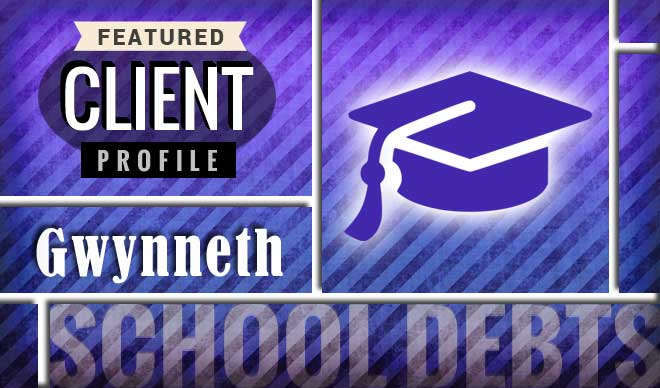Gwynneth pays off $55,000 in credit card debt

Contrary to popular belief, credit card debt does not always accumulate with excessive shopping sprees or irresponsibly living outside one’s means. In some cases, taking on this type of debt is essential to make necessary purchases and maintain living expenses. Before you know it, you have over $50,000 in credit card debt.
But no matter how you got into this debt, just know one thing: it’s not impossible to get out of, even if it does feel overwhelming at times. As well, there may be other options available to you than filing for bankruptcy. Here’s how Gwynneth was able to pay off $55,000 in credit card debt.
She was just a teenager when her debt problems began…
“Debt became a problem for me for various reasons. I was living in an expensive city and supporting myself from the age of 19,” says Gwynneth. “I was also pursuing a post-secondary education which neither I, nor my parents, could afford.”
In the late 1990s, Gwynneth decided to pursue a four-year undergraduate degree in Toronto. She began using credit cards in her twenties. After a few years, she owned about 5 credit cards. She returned to school for one year to complete a Bachelor of Education in her early thirties. Then she took out more loans with OSAP for teacher’s college.
“I was confident that with a teacher’s income I would be able to pay everything off,” she says. “In retrospect, I was extremely fortunate to get a job teaching in the public school system upon graduating.”
“But even with that stable income, it was more difficult than I realized to pay my debt.” – Consolidated Credit client Gwynneth #creditcardebt Click To TweetJuggling credit cards didn’t help…
Another issue that Gwynneth faced was the minimum payment requirements for her credit cards. When you have over $50,000 in debt, very little of that minimum payment will go towards the principal. High payments at 20% average APR or more will leave you struggling to pay off the balance, forcing you to stay in debt for longer than you should be.
On a standard 3% minimum payment schedule, Gwynneth was paying $1,500 per month for her debt. However, more than half of each payment ($833.33) would get used to cover the accrued monthly interest charges.
Gwynneth tried to manage these payments by using an additional credit card. Upon discovering she could not pursue borrowing from one credit card to pay for another, she consolidated her debt with a bank loan. This only proved to be a temporary fix and did not help with paying it off.
Making credit card debt manageable
Gwynneth finally turned to Consolidated Credit when her balances hit $55,000. She credits our debt management program for her success.
“The most effective part of the service is the holistic approach. It is how these elements worked together and supported one another,” she said. “Without one of the following elements I would likely have given up. I found paying off this debt very difficult emotionally, socially and financially.”
“Consolidated Credit not only managed my finances so that I paid off a $55,000 debt in about 5 years, they were very supportive throughout the process.” – Consolidated Credit client Gwynneth #creditcardebt Click To TweetGwynneth says that support made all the difference in her journey to become debt-free. “I felt that if I called them that I would connect with a friend who understood what I was going through.”
Gwynneth was able to pay off her $55,000 debt in 5 years because the program consolidated her bills and minimized interest charges. When you enroll in a debt management program, your creditors to reduce the interest rate applied to your debt to less than 10%. In some instances, the interest rate may be eliminated entirely, making it easier to reach your goal of being debt free.
In Gwynneth’s case, she only had to make one payment to Consolidated Credit, who managed her debt payments to her five creditors.
Getting support
Consolidated Credit also offers flexibility in payment due dates. For instance, Gwynneth was able to adjust payments to align with her income. If she was getting paid at the end of the week, she could postpone the monthly payment once for a few days until her check came in. “I wasn’t afraid or ashamed of calling because everyone who received my calls was friendly and non-judgmental,” she said.
Motivation and emotional support are also instrumental in paying off debt. When Gwynneth felt discouraged or needed help with budgeting, she would call Consolidated Credit, who would provide that support. “This confirmed to me that I was doing the right thing by sticking with the program and paying off the debt,” Gwynneth explains. “It was empowering.”
Financial lessons learned
Through it all, Gwynneth not only paid off her credit card debt but learned a valuable lesson: how to live within her means. “I learned through the five years that I could live within my income,” she said. “I lived frugally those five years and became uncomfortable with the concept of having debt and living cheque to cheque.
“The experience has changed the dynamic I have with money. I value money more.” – Consolidated Credit client Gwynneth #creditcounselling Click To TweetAnd instead of feeling limited by living within a budget, she’s motivated to stay out of debt. “I cherish that I have the opportunity to support myself comfortably within my means. I fear the perils of debt.”
Gwynneth now describes herself as “more relaxed and confident.”
“I have more spending money and money to save. The debt seemed unreal to me. So unreal, abstract and untenable that sometimes I imagine that the debt is still there. Then when I tell myself that it isn’t, that I paid it off, I am relieved. I can go on with life now.”
